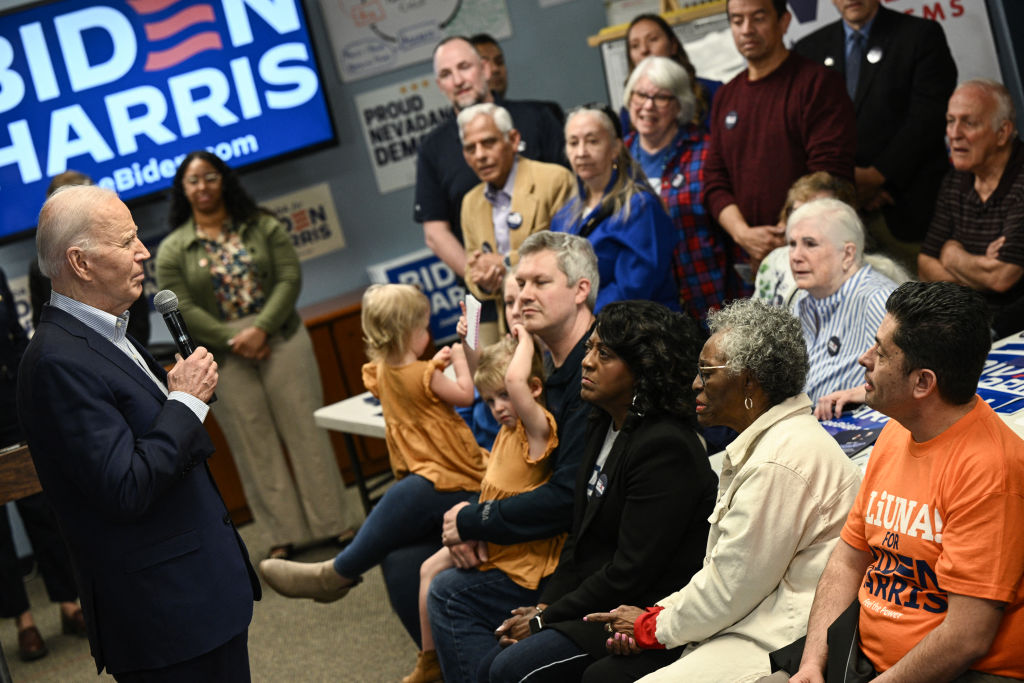How early in the election cycle is too early to begin looking for meaningful trends in polls?
Seven months out is too early, one of my editors told me this morning. In a normal election, sure. But America doesn’t have normal elections anymore.
A normal election would still have some suspense about the result of the out-party’s presidential primary in late March, especially if the frontrunner before voting began was facing scores of criminal charges.
In a normal election, an incumbent presiding over a strong economy wouldn’t have 73 percent of his own party telling pollsters that he’s unfit to serve another term.
In a normal election, we wouldn’t be asked to choose between two presidents, one current and one former, both disliked by more than half the country.
And in a normal election, the outcome wouldn’t meaningfully affect America’s commitment to the constitutional order.
More germanely for our purposes, in a normal election, the two candidates wouldn’t already enjoy worldwide universal name recognition at this point.
Early trendspotting in polling has traditionally been a fool’s errand, because one or both presidential nominees are little-known outside their home states when the general election campaign begins. As voters grow more familiar with their options, the numbers begin to move, sometimes dramatically—but that takes time. It would have been useless to try to read polling tea leaves this far out in a race between Joe Biden and, say, Ron DeSantis given that few people outside of Florida have strong opinions about the governor right now.
But a race between Joe Biden and Donald Trump? There’s nothing new to learn about either. Strong opinions abound. So when the polls move a bit, even seven months out, it’s tempting to conclude that something is happening to soften some of those strong opinions in a meaningful way.
And maybe something is. Analysts as esteemed as the New York Times’ Nate Cohn have looked at the latest data and are open to the possibility.
Today I want to flag two trends that might—or might not—be emerging in the early polling, as either would be hugely consequential if it pans out. One is the presidential race beginning to tighten, the other is ticket-splitting in swing states.
Yes, it’s early. But it’s later than you think.
In mid-December, Trump led Biden by 3.5 points in the RealClearPolitics national average. By the end of January, that lead had grown to 4.3 points.
Today, it’s 1.6 points.
In 20 polls tracked by RCP between late January and late February, Trump led in all but one. In the 16 polls taken since then, Biden has led in six and tied in another. If you include polls that RCP doesn’t follow, he leads in even more.
Individual pollsters have also seen movement. On Tuesday, Morning Consult published new data that found Biden gaining ground on Trump in six of seven swing states. The incumbent now leads in Wisconsin by a point and is tied with the Republican in Michigan and Pennsylvania. Winning those three Rust Belt battlegrounds would all but assure his reelection.
Something is happening—maybe. And if it is, there’s no shortage of possibilities as to why.
Start with the State of the Union. That speech wasn’t a “game-changer” for the president, but the fact that it didn’t change the game doesn’t mean it didn’t affect it at the margins. According to Morning Consult, the share of voters who said vice presidential nominees are more important this year due to Biden’s and Trump’s ages ticked down across all parties after the president’s reasonably energetic performance at the SOTU. Some left-leaning voters who were undecided about whether to risk giving him a second term might be drifting back into his camp.
Relatedly, Biden has kept a conspicuously busier schedule lately and mainstream media outlets are eager for American voters to know it. Some have even made a point of contrasting the president’s itinerary with his opponent’s. “As Biden tours the country and visits swing states, Trump is fundraising and playing golf,” a recent Associated Press headline blared. The Democrat has visited seven battleground states in the three weeks since the State of the Union, while the Republican has held just a single rally since March 12.
Age is Biden’s greatest political liability. For all the trouble he’s faced from inflation and has caused himself with immigration, I suspect he’d be on a glide path to a second term against Trump if he were 10 years younger. Frequent public appearances are risky for him insofar as even a single “senior moment” on camera might frighten voters, but the more visibly active he is, the easier it’ll be for undecideds who really don’t want a second Trump term to talk themselves into believing that Biden is fine.
And while there’s no way for the incumbent to convince Americans that he’s getting younger, he can certainly neutralize the issue to a degree by turning attention to Trump’s own age. Every verbal flub made by the former president in public appearances is now quickly clipped and circulated on left-wing social media, sometimes on Biden campaign accounts. The president himself has taken to commenting on those miscues in interviews. Allegations of dementia are now tossed around by Trump’s critics as well; less than a week ago, the Washington Post devoted a story to his family’s history of Alzheimer’s.
The message underlying this strategy couldn’t be plainer: In a race that features two candidates, not one, who no longer have their wits about them, you might as well take the guy who didn’t attempt a coup.
There are other factors that could plausibly be shrinking Trump’s lead. Top Democrats have eased their support for Israel considerably lately, which may be softening hard feelings among progressives towards the White House. Team Biden has also gotten a jump on advertising in swing states with a six-week $30 million buy that’s still in progress. And simple public awareness of Trump clinching the Republican nomination—with all the insanity that portends for the next seven months and beyond—may have tilted some undecideds into the president’s camp, temporarily or not.
The Biden comeback could be underway. But what kind of pessimist would I be if I didn’t consider the grim alternative?
Start with this, which makes me think that ending the American experiment might not be a bad idea after all.
Trump’s favorability is underwater in the RCP poll tracker, but his numbers are still marginally better than Biden’s. Multiple impeachments, indictments, and a coup plot that played out in full public view haven’t been enough to sour citizens of The Greatest Country in the World on the Republican nominee.
Look closely at the national head-to-head polling and you might also find less to “the Biden comeback” than meets the eye. For starters, the president hasn’t actually gained much support over the last five months: On November 1, he stood at 44.9 percent in polling and today he stands at 45.0 percent. In fact, apart from a few brief dips, his share of the vote has remained stuck between 44 and 46 percent since last summer.
A ceiling of 46 percent is … not great for an incumbent, especially when his challenger’s ceiling is higher. Trump touched 47.8 percent earlier this month and has been north of 47 percent numerous times since last fall. “The Biden comeback” may be less of a true comeback, it appears, than a mere polling artifact of Trump’s numbers surging following big early primary wins in Iowa and on Super Tuesday and then falling back a bit as those bounces faded.
If you need further evidence, examine the president’s job approval rating. On November 1, 40.8 percent approved of Biden’s performance; today, 40.4 percent do. Not since September of last year has he averaged as high as 42 percent in that metric and not since October 2021(!) has he been as high as 45 percent. If Americans are brightening on a second Biden term, even only insofar as they deem it preferable to a second Trump term, that brightness should be evident in his job approval at some point, no?
You can dismiss all of this if you like by insisting that the reality of a third Trump nomination still hasn’t fully hit voters and that the numbers will shift meaningfully once it does. Maybe. But I would remind you that Trump is winning right now despite having made no real effort yet to woo disgruntled “Nikki Haley conservatives,” which is likely to change as the election approaches. And that, unlike in 2020, there are multiple significant third-party candidates this cycle who appear poised to pull more votes from the left than from the right. And that the probability of Joe Biden making it to November without demonstrating serious signs of advanced age in public is exactly zero.
Any candidate polling this weakly against a figure as morally and civically degraded as Donald Trump is one whom Americans really, really don’t want to be president. That will not change meaningfully before Election Day.
So maybe we should start thinking about races down ballot. If the presidency is a lost cause, it will be crucially important to have Democrats in charge of Congress.
But how likely is that? Typically, when a party wins at the top of the ballot, its nominee carries its candidates to victory on his coattails in close congressional races. That should be especially true in modern America, one would think: The more hyperpartisan our politics gets, the less we should expect to see voters splitting their tickets by preferring one party’s candidate as president and the other party’s candidate(s) for lower office.
So imagine my surprise when I stumbled across this data.
Emerson is just one pollster, you might say. Surely the RCP averages in swing states show greater alignment between the presidential race and Senate races.
But they don’t, it turns out. In Pennsylvania, Trump leads by 0.2 points while Democrat Bob Casey leads by 8. Nevada: Trump by 3 points, Democrat Jacky Rosen by 4. Michigan: Trump by 3.5 points, Democrat Elissa Slotkin by 1. Wisconsin: Trump by 0.8 points, Democrat Tammy Baldwin by 3 in the latest poll there. Arizona: Trump by 5.2 points, Democrat Ruben Gallego by 4 in the latest poll.
Montana and Ohio will be gimme victories for Trump this fall. In the former, Democrat Jon Tester leads the Senate race by 5.5 points. In the latter, Democrat Sherrod Brown leads by 5.
How seriously should we take this? Is it a real trend?
There’s a case that it is. It could be as straightforward as younger progressive voters taking out their frustrations over Gaza on the president, who sets foreign policy, when speaking with pollsters while exempting their party’s Senate candidates from their wrath.
But I think there’s more to it, as I noted last month when Democrat Tom Suozzi continued the Democrats’ hot streak in special elections by winning comfortably in New York’s 3rd District. Suozzi had many advantages, starting with the fact that the left’s higher-educated base turns out more reliably for elections held at odd times. But it’s strange that Joe Biden’s party has overperformed in congressional races for the last several years, in particular in the 2022 midterms, given how deeply and durably unpopular the president himself is. He should have “reverse coattails,” yet he doesn’t. Why not?
My theory is that Biden’s age is such a singular political liability for him that it ends up insulating his party from him down ballot. If voters perceive his deficiencies on policy as mainly a function of him not being up to the job, then it’s hard for them to attribute his failures to younger Democratic officeholders. To repeat a point I made in February: “If you’re the sort of person who views America as functionally leaderless right now due to the president’s questionable health, it might be easy to view Tom Suozzi and other congressional Democrats as independent actors rather than servants to the White House.”
But don’t take my word for it. The Republican State Leadership Committee has begun advising state-level candidates not to make their races a referendum on Biden because, in Axios’ words, the president “doesn’t hurt candidates down ballot in the way some presidents have in the past.” An internal poll for the group found that not even half of voters say they’re less likely to support a state candidate who supports Biden’s reelection despite the fact that disapproval of his performance now stands north of 56 percent nationally.
Biden might be sui generis as an incumbent—too disliked to be reelected himself yet somehow also too personally debilitated to have his political sins held against his party.
Split-ticket voting might be less common than it used to be, but it’s not as unusual as you might think. Candidate quality drove some dramatic splits in the 2022 midterms, as a forlorn Mitch McConnell might tell you. This year, “double-hater” voters who dislike Trump but consider him slightly less unfit than Biden might nonetheless prefer a Democratic Senate to hold him in check given the loose talk about “retribution” and suspending the Constitution that emanates periodically from Mar-a-Lago.
The early Senate polls could be detecting a real trend. But what kind of pessimist would I be if I didn’t consider the grim alternative?
The obvious counterpoint to all of the above is that most Democrats who are leading in a Senate battleground right now are incumbents. The two exceptions are Arizona and Michigan, where the races are for open seats, and in Arizona, voter skepticism of Kari Lake might plausibly soften as voters start to scrutinize the progressive Gallego.
That is to say, nearly all of these Senate contests are traditional ones of the sort I described at the start of this piece, in which one candidate is very well-known and the other much less so. The well-known candidate, typically an incumbent, will lead early by dint of greater name recognition, but the numbers can shift sharply as the unknown begins to make an impression on voters. How much of a “trend” is a dog-bites-man story like that, really?
Consider this data point, too, from pollster Patrick Ruffini:
That’s a big enthusiasm gap among so-called MAGA Republicans between turning out for their hero and turning out for candidates down ballot. Maybe they’re telling pollsters disproportionately that they’re undecided in Senate races, as they don’t care enough about those contests to have developed an opinion about either candidate. If so, that would explain why Democratic Senate candidates enjoy small leads right now.
But we wouldn’t expect those leads to hold on Election Day. Most MAGA Republicans who turn out for Trump will end up voting for the party’s nominee for Senate too, however dispassionately, simply because they will have an R next to their name. Hardly anyone leaves a line on their ballot blank unless they strongly disapprove of all of their choices, and most of the GOP’s Senate nominees won’t offend populist sensibilities. The polls could, in other words, be underestimating Trump’s own coattails down ballot—and not for the first time.
Meanwhile, to the extent Democratic candidates are benefiting from an impulse to restrain a second Trump presidency by ensuring his opponents control the Senate, voters may eventually realize that there’s all but zero chance of that scenario happening.
With Joe Manchin retiring, West Virginia’s open Senate seat is destined to flip from blue to red. That will leave the Senate 50-50 even if Democrats manage to defend all of their battleground seats (unlikely), which means Trump’s vice president would provide the tie-breaking vote in a deadlocked chamber. For Democrats to retain a majority, they would need to flip a red seat somewhere to get to 51. And the prospects of that are grim, especially with Larry Hogan now a serious threat to flip another blue seat in Maryland.
The Senate is going red, one way or another. The presidency is probably going red too, especially if swing voters currently inclined to vote for Democrats down ballot are already signaling a willingness to cross over at the top of the ballot to vote for Trump. And it’s later than you think.
But both of these polling trends will be worth watching this spring and summer as voters get to know the Republican Senate challengers better and try to cope with the fact that Trump and Biden really are their only options to lead the country. I expect we’ll settle into a miserable homeostasis with Trump narrowly and reliably ahead while some 10 to 15 percent of the electorate absolutely refuses to make up its mind until October, when both sides will unload every dirty political trick they can think of. And even then, many of those undecideds will end up opting for third-party candidates, denying the eventual winner of the election anything close to the forceful legitimacy of 50.1 percent of the vote.
There’s no “good” outcome in the offing, only shades of bad. That’s what a country gets when it chooses not to have normal elections anymore.







Please note that we at The Dispatch hold ourselves, our work, and our commenters to a higher standard than other places on the internet. We welcome comments that foster genuine debate or discussion—including comments critical of us or our work—but responses that include ad hominem attacks on fellow Dispatch members or are intended to stoke fear and anger may be moderated.
With your membership, you only have the ability to comment on The Morning Dispatch articles. Consider upgrading to join the conversation everywhere.